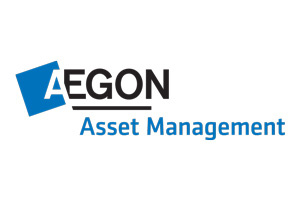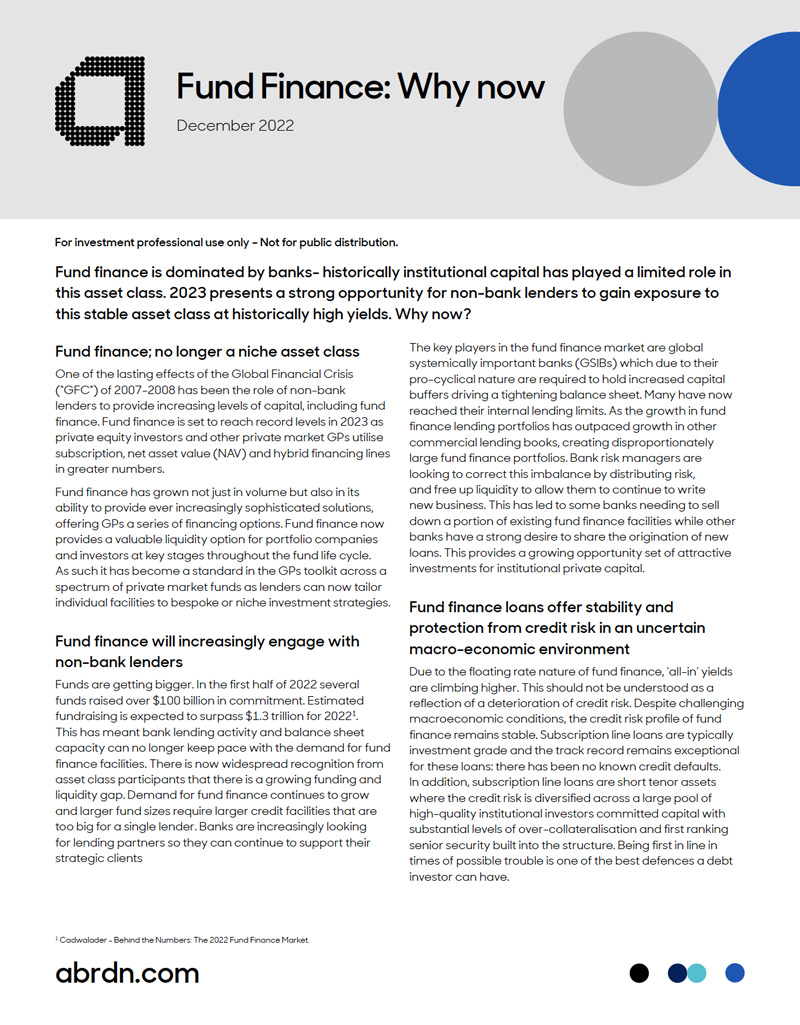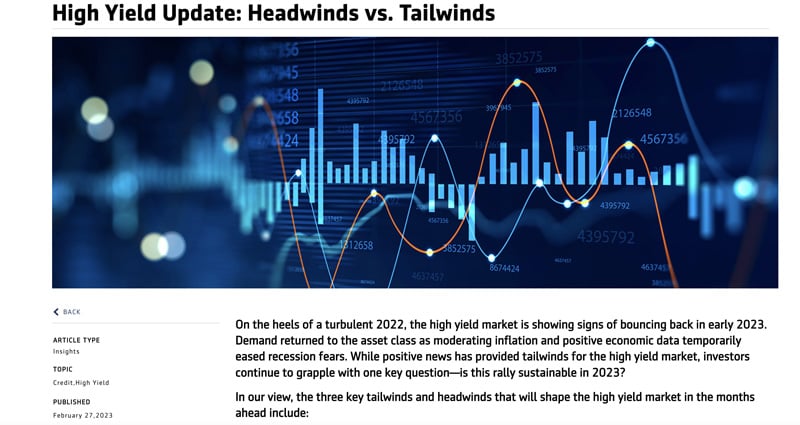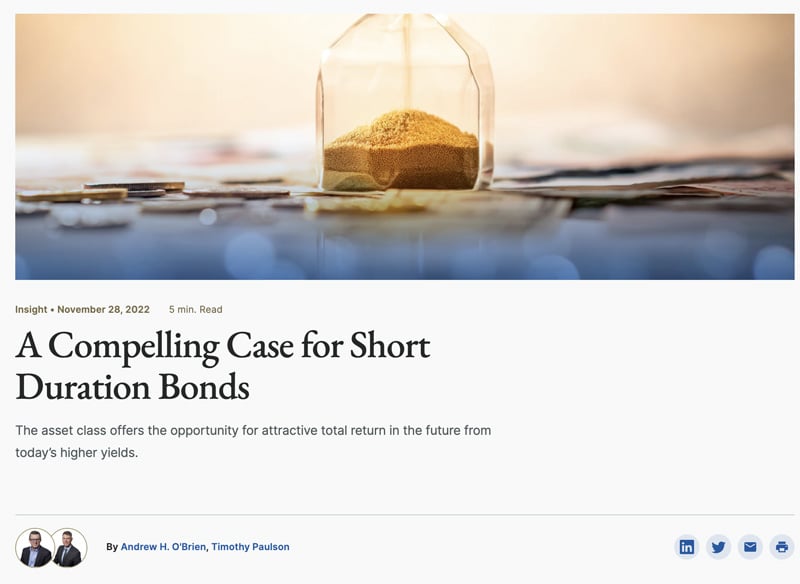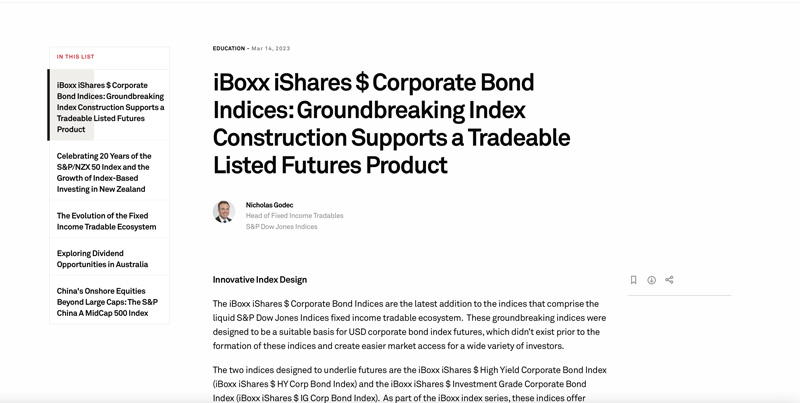
SEARCHING FOR THE RIGHT FIT
Institutions are actively reassessing their fixed-income portfolios, taking lessons learned from last year and reviewing current opportunities that can provide diversification and income. After a dismal 2022, when both bonds and stocks suffered steep declines, and now facing ongoing economic uncertainty, plan sponsors are looking to get back on track to deliver positive return from their fixed-income allocations.
Institutions’ biggest worry, according to Timothy Paulson, investment strategist, high grade, at Lord Abbett, is the changing role of fixed income in the portfolio. “Many institutions are telling us that ‘I’ve traditionally thought of fixed income playing a protective role in my portfolio, and it didn’t work,’” he said. “It’s true that bonds have provided protection much of the time over the last few decades, but investors aren’t guaranteed this outcome.”
“In the years of very low rates,” he continued, “it was hard for bonds to play their customary role of providing income. The yields just weren’t there, so protection and diversification justified their inclusion. The good news is now that yields are higher and we have income again, we can go back to the traditional playbook. Investors can focus more on bonds’ income and total-return benefits while thoughtfully evaluating their diversification role.”
Fixed Income Webinar




Heightened focus
Brian Luke, senior director and head of fixed-income indices, Americas at S&P Dow Jones Indices, cited three major concerns: price transparency, trade efficiency and interest-rate risk. “Institutions are continually concerned about transparency and trade efficiency. In volatile markets that move fast like we saw last year, for instance, visibility on prices and trading volumes can be opaque or potentially nonexistent. Investors need clear information to gauge what’s happening, and index-based products like exchange-traded funds can be the best way to get that information and thus help investors make better decisions. These products are also very efficient because they enable large investors to save significant trading costs in terms of dollars, time and resources.”
Read: The Evolution of the Fixed Income Tradable Ecosystem
Luke additionally sees heightened sensitivity about the direction and level of interest rates. “As the Federal Reserve continues to tighten, and the market is nervous that the tightening can go higher than expected,” he said, “our clients are looking at their overall interest rate exposure and how they can gain an advantage through their duration positioning. They’re trying to achieve shorter duration and are using index-based products to focus on the shorter end of the yield curve.”
Slowdown concerns
James Schaeffer, global head of leveraged finance at Aegon Asset Management, said that clients are expressing apprehension about the potential length and strength of a recession. “Institutions are concerned about the persistence of inflation, which could drive the Fed to keep hiking rates and make a recession more severe than the market expects. Investors are worried that they’re going to be in this environment longer than they expected.”
Investment Strategist, High Grade
For credit investors, Schaeffer said, “The big question becomes whether the recession brings higher defaults. If they’re allocating to higher-spread asset classes, they could see a higher level of defaults and downgrades than they expected, as well as more upward pressure on yields. We hear that concern from almost every client that would likely delay an allocation decision.”
A TIME OF RECKONING
The bond market’s 2022 meltdown was a reckoning for investors accustomed to a healthy economy and rock-bottom interest rates, which allowed fixed income to generate stable returns and serve as a diversifier to equities. For the first time in decades — and in the lives of many investors and asset managers — inflation soared and the Fed aggressively raised rates, both of which have continued into this year.
The macroeconomic environment remains uncertain, leading institutions to continue to seek clarity on these questions: For how long will above-normal inflation persist? How much more will the Fed tighten and when will it stop? Will there be a recession, and if so, for how long?
What is certain is that institutions cannot afford to leave their fixed-income approaches unchanged. They must rethink the purpose of the asset class and adjust their strategies and allocations accordingly.
A flexible mindset
Asset managers point to a number of lessons that plan sponsors can incorporate into their fixed-income strategy going forward.
The list should start with the importance of capital preservation, according to Shelley Morrison, head of fund finance and asset-backed securities at abrdn. “At times, capital preservation can seem a little boring and it can be tempting to get overly excited about assets that promise to deliver double-digit growth,” she said. “But last year demonstrated the need to protect against the downside and the dangers of neglecting that critical element within your wider portfolio. Institutional investors now are paying more attention to assets that could be considered credit stabilizers.”
Head of Fund Finance
and Asset-backed Securities
Morrison added, “Institutional investors have learned that there is a need to be agile and flexible, and not too wedded to a single allocation strategy. They’re always asking us, ‘Can we pivot when we need to?’ I also think that volatility and uncertainty are here to stay, and we need to learn to get comfortable with them.”
Complacency can hurt
For Aegon’s Schaeffer, two words stand out as lessons from 2022: complacency and velocity. “Investors got very complacent about rates being historically low for so many years,” he said. “The mindset was that fixed income was a source of portfolio diversification and modest potential upside with limited downside, and not an income generator. A lot of investors and managers had never been through an inflationary environment, so they had little sense of what inflationary pressures could do to the economy and the markets.”
“Velocity means the speed of market behavior,” Schaeffer continued. “While investors expected some degree of inflation and Fed tightening, they didn’t expect these scenarios to happen so quickly. They simply weren’t prepared for the velocity of how markets reacted. For me, the lesson is that you’ve got to think about the downside relative to market expectations and where things could go wrong, and not be complacent in your positioning.”
Strategic re-assessment
It’s important that investors continually assess the role of fixed income in the total portfolio context, said Kristen Doyle, head of U.S. institutional market strategy at Lord Abbett. “Investors are rightly taking a hard look at the roles of different fixed-income segments and considering whether we’re in a new regime and how that affects fixed-income allocations at the strategic level and within the asset class itself. We’re seeing forward-looking return expectations from consultants going up. So when you run asset allocation models now, they’re going to say you should have an allocation or a higher allocation to fixed income.”
Doyle also noted that the reversal of long-term trends can test the validity of concepts that investors take for granted. “The major assumptions in this case were the relative stability or predictable returns of any asset class, the relationship between asset classes and the basics of portfolio construction,” she said. “It’s so easy to believe that since the world has worked in a certain way for the last 10, 20 years, we must extrapolate that forever. Sometimes it takes a shock like what happened in 2022 to make us question some of these assumptions.”
Read: Why floating-rate loans?
Aegon’s Schaeffer said, “What so many missed was how quickly the Fed shifted policy. Investors tend to underestimate how the Fed will move when they move and have these visions of long-term dot plots that go out for years. This mindset came from many years of everyone expecting rates to go higher when they were so low, but they never did. We were wrong, as we got tremendous inflationary pressure and were surprised at how quickly rates could move much, much higher.”
But, he added, “what some investors really got right was to be in floating-rate instruments, short-duration fixed income and cash. Cash was really the winner in that kind of environment. Those who recognized what was going on and made those moves definitely helped themselves.”
The role for Treasuries
Lord Abbett’s Paulson noted that many plan sponsors should now reconsider the role of Treasuries. “There’s something about a prolonged zero-rate environment that distorts markets and forces investors to make inefficient decisions, like allocating to Treasuries because there’s nowhere else to go.”
“Treasuries had no inherent value because their real yields were negative,” he added, “so their usefulness had to be as a diversifier. And if they lose that diversification feature as they did in 2022, all that’s left is their liquidity advantage. Investors then should ask, ‘Do I have more liquidity than I need?’ which leads to, ‘Should I rethink what my liquidity profile looks like?’ and ultimately, ‘What role should Treasuries play in my portfolio?’”
WHAT’S NEXT?
While fixed-income managers are interpreting the current macroeconomic indicators in different ways, they all agree that investors can achieve targeted yields and even exploit opportunities to generate alpha.
Abrdn’s Morrison is cautiously optimistic about the economy and its implications for fixed income. For credit investors, “2023 may deliver less pain and more gain compared to 2022. It can’t possibly be as bad as last year. But that’s not to say that the market will be easy. The macro environment clearly will remain challenging, and volatility should be a constant.”
“Elevated inflation and rates have already caused the bulk of potential contraction in economic growth,” she added. “In this environment, investors should be able to find a traditional safe haven in fixed income, where yields can help to offset price risk. In particular, there should be increasing demand for government bonds and private credit assets.”
Potential paradigm shift
In Lord Abbett’s view, the persistent divergence between market expectations for Fed cuts and the Fed’s own rhetoric and projections will lead to further bouts of market volatility. “Events in the banking sector have certainly made the Fed’s job — navigating a soft landing while bringing inflation back to target levels — much more difficult, and we expect continued tension between the Fed’s needs to fight inflation appropriately and credibly and the market’s desire for rate relief on the front end. It’s fair to say that we think, once again, the market has gotten ahead of itself with regard to anticipating rate cuts that are still fairly unlikely,” Paulson said.
Global Head of Leveraged Finance
“It’s fair to say that we’re in the ‘higher for longer’ camp,” he continued. “The market hasn’t yet reckoned with [the] potential paradigm shift that a higher-for-longer world would require.”
Aegon’s Schaeffer has a somewhat similar outlook. “The biggest challenge right now,” he said, “is whether inflation will be persistent even as it appears to be slowing. And that’s a concern, because the longer it goes and the higher the Fed needs to hike, the greater the risk of a deeper recession. Once rates get to 5% or a little higher,” he added, “we believe we’re going to see a pause [at the Fed] for the remainder of 2023 and even into early 2024. We think the Fed will be very focused on ensuring that they’ve dealt with services inflation, wage pressures and low unemployment.”
Corporate credit focus
Corporate credit is attractive across the ratings spectrum, according to Nicholas Godec, head of fixed income tradables at S&P Dow Jones Indices. “The key is that higher rates have put income back in play,” he said. “Investors are now seeing potential investment-grade entry points, in the form of yields, that they haven’t seen in the past decade. At the same time, IG credit spreads are close to their historical average, so you can buy quality credits at yields that haven’t been available for years while the pricing of credit riskiness hasn’t changed much.”
Within corporate credit, Godec noted, high yield offers an interest rate-risk profile that compares favorably to that of investment-grade fixed income. “If you’re looking at corporate credit as a yield and duration play, you have significantly less duration in high yield than IG. [As of Jan. 31], the modified duration of the iBoxx USD Liquid High Yield Index was 3.9 years versus 8.4 years for the iBoxx USD Liquid Investment Grade Index; the index yields were 7.9% and 5%, respectively. In other words, high yield is giving you more yield for less duration risk. This is important for anyone concerned about their portfolio’s rate sensitivity.”
Read: Adapting Allocations to a New Regime
Godec also sees value in broadly syndicated leveraged loans, which usually are floating-rate obligations. “What we like about leveraged loans is that they give you credit exposure — typically sub-investment-grade credit — with solid yields regardless of where interest rates are. And because the securities are floating rate, their duration tends to be between zero and half a year. So you’re taking minimal duration risk in any sort of rate environment.”
Doyle of Lord Abbett encouraged credit investors to be more open to idiosyncratic opportunities that they typically wouldn’t pursue. “We’re often finding opportunities that don’t fit in benchmarks or traditional mandates and that can offer wider spreads and better risk-return profiles. A good example is small issues of corporate bonds or securitized debt, maybe $50 million to $100 million for the whole issue.”
“It can sometimes be a challenge for large institutional investors,” she continued, “to determine where to place these liquid alternative strategies. Some may decide to put them in their opportunistic allocation or a return-seeking fixed-income bucket. It’s a different way to allocate a piece of the active risk budget, to a manager that can source these types of opportunities consistently.”
Interest in fund finance
Morrison at abrdn is bullish on private credit. “Private credit continues to present very strong opportunities for institutional investors, particularly insurers and pension funds. That’s because it’s a good strategy for investors looking for any combination of capital protection, reduced volatility, diversification or a hedge against inflation, since most private credit assets are floating rate.”
Private credit “has shown itself to be resilient over the last year. And it’s an asset class that can deliver attractive risk-adjusted returns in benign markets and really stressed markets as well,” she added. “New loans are being originated at much wider spreads, sometimes up to 200 basis points wider than the equivalent public markets pricing.”
Within private credit, Morrison is especially enthused about fund finance, which provides secured loans to private market funds, such as private equity buyout funds or private credit funds, either to bridge the fund’s investment activity or leverage the asset portfolio. Bridging loans are secured against unfunded commitments from large investors, such as insurers, sovereign wealth funds, funds of funds, pension funds, endowments and foundations. These loans are typically rated A or AA and usually have short duration with maturities of less than two years.
“This is an asset class that can be very resilient, with historically low volatility and an extremely stable credit profile,” she said. “It offers portfolio diversification because it has little correlation to other asset classes. And it can be a credit stabilizer that’s a bit more liquid than some other illiquid strategies. Some institutional investors are not aware of fund finance because it has been dominated by the big commercial and investment banks — [but] it presents a timely opportunity to meet many of their current portfolio objectives.”
The fund finance market is expected to expand to $700-plus billion by 2030, Morrison noted. “It’s at the point where a single bank can’t meet demand anymore, so these have become club trust funds or small syndicated loans. On top of that, there are supply-side constraints due to tighter bank liquidity as new capital requirements are forcing U.S. banks to pull back their lending in this space.” These factors have had two main effects, she said: They have pushed margins higher by around 20 basis points and created a funding gap where banks can no longer meet the demand.
Institutional investors have filled that gap, with “insurers and pension funds increasingly providing loans directly to the underlying private market funds,” Morrison said. “Clearly, investors looking for potential stability and protection from credit risk in an uncertain environment should consider an allocation to fund finance. It offers a lot of what investors want now and the pricing is really attractive too.”
High-yield fundamentals
Aegon’s Schaeffer sees current opportunities in high yield and leveraged loans. High yield is fundamentally attractive, he said, with solid balance sheets, leverage at 10-year lows and strong coverage ratios. Aegon especially likes that there aren’t many upcoming maturities, which gives companies a longer runway to manage challenges [See chart].
In the past few years, he said, “so many companies raised debt capital and pushed out maturities. Although we’re going to see some credit deterioration due to economic weakness, these companies have a cushion of time to manage it. So even in a recessionary environment, there shouldn’t be a big pickup in defaults like in past years. Therefore, we see opportunity at today’s yields.”
“Our view on leveraged loans is similar but with another layer of risk,” Schaeffer continued. “While they’re floating rate, which helps them outperform when rates rise, higher rates have a greater impact on the cash flows of the underlying companies. There are a lot of businesses in the leveraged loan universe that are unique, so we see a bit more credit risk in leveraged loans versus high yield in terms of potential defaults and recessionary impact.”
SELECT THE APPROPRIATE APPROACH
Compared with equities, passive strategies have been less accepted in fixed income, although they have gained a larger footprint in recent years. Where would a passive allocation make sense in today’s environment, and where does active remain most beneficial to meet specific portfolio objectives?
S&P DJI’s Luke sees passive vehicles as an efficient way for a fixed-income investor to achieve exposure to a huge, diverse asset class. In addition, he notes, active managers are increasingly using indexes as a tool in their toolbox, particularly for large institutional fixed-income allocations.
Senior Director and Head of Fixed Income Indices - Americas
More and more, he said, “we’re seeing active managers using index-based products for a variety of purposes, whether to minimize cash drag, maintain [the] liquidity required by their mandates or even to adjust risk levels by shortening duration and equitizing cash. Active managers can use index-based tools to set broad or granular exposures to specific fixed-income subsectors.” Luke also pointed to exchange-traded funds and other instruments that track subcomponent indexes for Treasuries, mortgage-backeds, corporates or asset-backeds, all of which have instruments that focus on a specific rating or duration tier.
“The flow numbers speak for themselves,” he added. According to Morningstar, active bond mutual funds lost $529 billion in outflows in 2022 while ETF.com reported that bond ETFs — most of which are passive — had inflows of $189 billion. “That’s an 8% annual inflow gain in a year when bonds took a beating,” he said.
S&P DJI’s credit derivative products saw record-setting trading volumes last year, while trading volumes for its total-return swaps and futures linked to its corporate bond indexes stayed close to their previous highs, Luke noted. “In times of market stress, investors have learned to look at and utilize these fixed-income index-linked products.”
Read: A tailor-made approach to fund financing
Luke said he expected the popularity of passive vehicles to continue to rise among fixed-income investors. “The lion’s share of the flows that have gone into bond ETFs have gone to index-replicating products. That speaks volumes [about] what investor preferences are and how they’re implementing those preferences. The ability to access the market through a liquid, low-cost, diversified index-based approach should result in greater adoption by all types of clients, whether retail or institutional.”
Active remains in season
While active managers see a place for passive positions in a fixed-income portfolio, their belief in the merits of an active approach is unshakeable.
“For beta or exposure to certain highly liquid sectors like generic high-grade bonds or Treasuries,” said Lord Abbett’s Paulson, “why not use passive vehicles? But when you have to sort through the hundreds of thousands of fixed-income instruments to find opportunities, active management is the way to go. Our institutional clients are very clear that, particularly in the bond world, active provides significant benefits.”
“There are noneconomic activities in fixed-income markets that active managers can help monetize,” he added. “It could be distortions from credit ratings, downgrades, forced selling or enormous buying by central banks, or noneconomic or regulatory distortions from banks and insurance companies. Active managers can identify and exploit the mispricings that result from these factors.”
As Aegon’s Schaeffer put it, “Investors need managers with a robust research capability to evaluate companies and credits and understand downside risk. Active management is all about finding dispersion and taking advantage of it.”
The fixed-income market currently exhibits considerable dispersion and volatility, he pointed out. “It’s precisely the kind of environment where active shines. We are going to see dispersions all across spread product, whether it’s in investment grade, high yield, leveraged loans, securitized or just about anything in the public markets. That creates opportunity. This is the type of year where it’s pretty clear that buying the index will leave you behind what a good active manager can achieve.”

